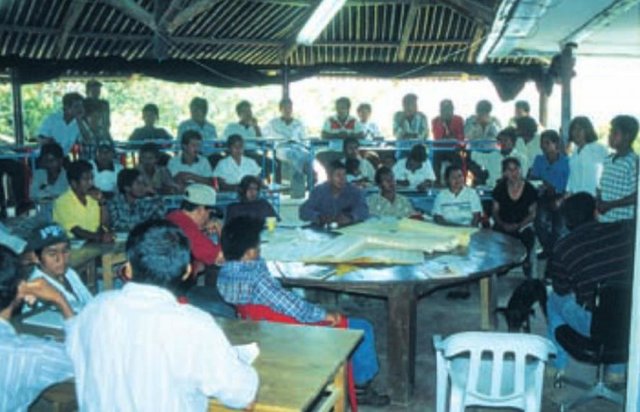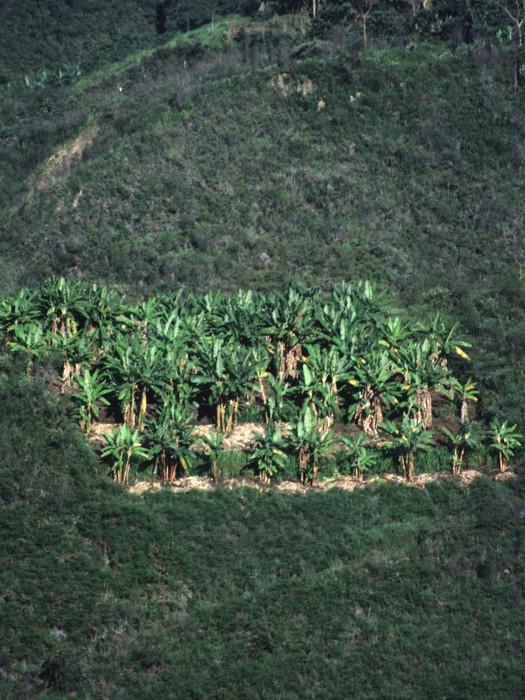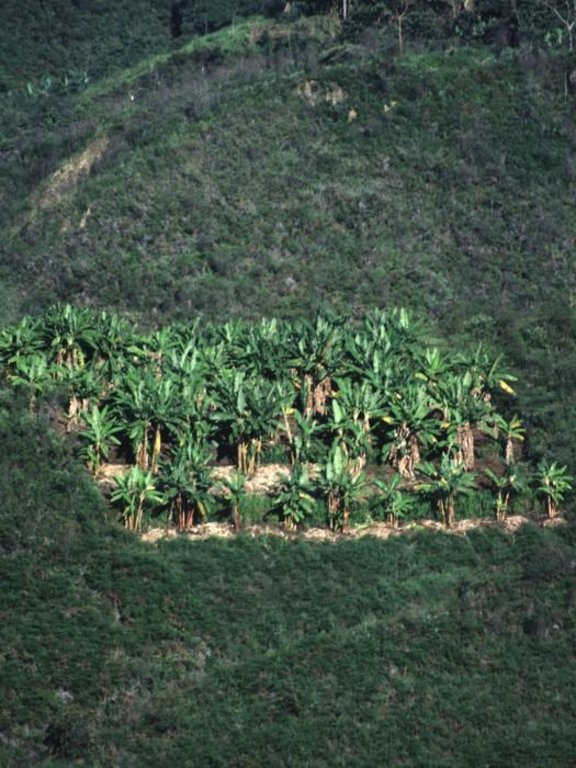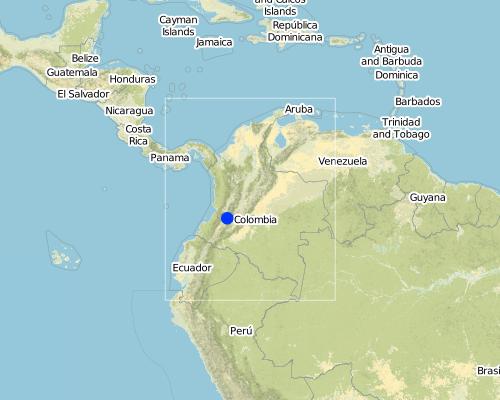Intensive agroforestry system [كولومبيا]
- تاريخ الإنشاء:
- تحديث:
- جامع المعلومات: Mathias Gurtner
- المحرر: –
- المُراجع: Deborah Niggli
Silvoagricultura (spanish)
technologies_1023 - كولومبيا
عرض الأقسام
توسيع الكل طي الكل1. معلومات عامة
1.2 تفاصيل الاتصال بالأشخاص الرئيسيين لمصدر المعلومات والمؤسسات المشاركة في تقييم وتوثيق التقنية
اسم المشروع الذي سهّل توثيق/تقييم التقنية (إذا كان ذلك على صلة)
Book project: where the land is greener - Case Studies and Analysis of Soil and Water Conservation Initiatives Worldwide (where the land is greener)1.3 الشروط المتعلقة باستخدام البيانات الموثقة من خلال WOCAT
متى تم تجميع البيانات (ميدانيا)؟:
01/07/2004
يوافق جامع المعلومات والشخص (لاشخاص) الرئيسي لمصدر المعلومات على الشروط المتعلقة باستخدام البيانات الموثقة من خلال WOCAT:
نعم
1.4 إعلان بشأن استدامة التقنية الموصوفة
هل التقنية الموصوفة هنا تمثل مشكلة فيما يتعلق بتدهور الأراضي، بحيث لا يمكن إعلانها تقنية مستدامة لإدارة الأراضي؟:
كلا
1.5 الإشارة إلى الاستبيان (الاستبيانات) حول مناهج الإدارة المستدامة للأراضي

Desarrollo Rural Integral Comunitario [كولومبيا]
En un proceso participativo y comunitario y a través de la capacitación, la asistencia técnica y la suministración de insumos importantes se fomenta el establecimiento de un sistema agrosilicultural en la comunidad indÃgena.
- جامع المعلومات: Mathias Gurtner
2. وصف تقنيةالإدارة المستدامي للأراضي
2.1 وصف مختصر للتقنية
تعريف التقنية:
A protective and productive high-input agroforestry system comprising multi-purpose ditches with bunds, live barriers of grass, contour ridging,
annual crops and fruit trees.
2.2 وصف تفصيلي للتقنية
الوصف:
The intensive agroforestry system (silvoagricultura) combines traditional and newly developed practices adapted to the area’s conditions. The idea is to concentrate cropping on a limited area, a plot of 0.4 ha per household, in a highly integrated, intensive and diversified continuous land use system, thereby integrating soil and water conservation - specifically avoiding traditional slash and burn practices.
Each ‘agroforestry plot’ comprises four to five 50 cm wide and 40 m long multipurpose ditches that are excavated along the contour, 6 to 12 m apart, depending on the slope. The ditches retain runoff water which infiltrates the soil, thus reducing erosion and improving soil moisture. They also act as compost ditches for all types of organic residues on the farm. Residues, enriched with manure (from chickens and guinea pigs) are tipped into the ditches, and within 8 to12 months this decomposes into a fertile medium for the cultivation of vegetables and other crops.
The main purpose is to increase and diversify production, and at the same time to protect natural resources and regenerate degraded areas.
Grass strips are planted on the earth bund on the upper side of the ditch for stabilisation of the structure, retention of runoff and capture of eroded sediment. The grass is cut several times a year to feed guinea pigs, which in turn recycle this into manure. On the lower side of the contour ditches, fruit trees and bananas are planted. Rows of multipurpose trees (mainly indigenous species) are planted around each agroforestry plot as a windbreak and for economic reasons: yielding fruit and timber. Between the structures, annual (and semi-perennial) crops are grown on hand-dug micro-terraces/ridges, again sited along the contour. Some farmers intercrop with legumes. Supportive technologies are protection of wells,
afforestation and, where possible, irrigation to enhance production. Production is based on principles of organic farming.High initial inputs of external manure are subsidised by the project (CISEC; see associated approach). The remainder of each farmer’s land is left to natural regeneration, reforested, or where needed, used for conventional cropping
The system is implemented on degraded and often steep slopes in subhumid areas where intensive rainfall and dry periods alternate. The land is officially owned communally (an ‘Indigenous Reserve’), but land use rights are individual. The region has a high population density: people are basically of indigenous origin and live in very poor conditions.
2.3 صور التقنية
2.5 البلد/المنطقة/المواقع التي تم تنفيذ التقنية فيها والتي يغطيها هذا التقييم
البلد:
كولومبيا
المنطقة/الولاية/المحافظة:
Cauca
مزيد من التفاصيل حول الموقع:
Santander de Quilichao
Map
×2.7 إدخال التقنية
حدد كيف تم إدخال التقنية:
- من خلال المشاريع/ التدخلات الخارجية
3. تصنيف تقنية الإدارة المستدامي للأراضي
3.1 الغرض الرئيسي ( الأغراض الرئيسية) للتقنية
- تحسين الإنتاج
- الحد من تدهور الأراضي ومنعه وعكسه
3.2 نوع (أنواع) استخدام الأراضي الحالية حيث يتم تطبيق التقنية

مختلطة (محاصيل/ رعي/ أشجار)، بما في ذلك الحراجة الزراعية
- الحراجة الزراعية
التعليقات:
Major land use problems (compiler’s opinion): - soil degradation/reduced soil fertility
- inappropriate soil management: monoculture, slash and burn, no or short fallow periods
- intensive rainfall on steep, unprotected slopes
- drought and wind erosion in dry season
- lack of economic resources
- high population density
Constraints of degraded land (before SWC)
3.3 مزيد من المعلومات حول استخدام الأراضي
إمدادات المياه للأرض التي يتم تنفيذ التقنية عليها:
- بعلية
حدد:
Longest growing period in days: 240, Longest growing period from month to month: october untill may
3.4 مجموعةالإدارة المستدامة للأراضي التي تنتمي إليها هذه التقنية
- الحراجة الزراعية
- تحسين الغطاء الأرضي/النباتي
- التدابير المتقاطعة للمنحدرات
3.5 انتشار التقنية
التعليقات:
Total area covered by the SLM Technology is 1.2 m2.
3.6 التدابير التقنية في مجال إلادارة المستدامة للأراضي

التدابير الزراعية
- A1: الغطاء النباتي/التربة

التدابير النباتية
- V1: غطاء من الأشجار والشجيرات
- V2: الأعشاب والنباتات العشبية المعمرة

التدابير البنيوية
- الحواجز والضفاف
- S3: الخنادق المتدرجة ،والقنوات، والممرات المائية
- S4: تسوية الخنادق والحفر
التعليقات:
Type of agronomic measures: mixed cropping / intercropping, manure / compost / residues
3.7 الأنواع الرئيسية من تدهور الأراضي التي تناولتها التقنية

تآكل التربة بالمياه
- الوزن(Wt): فقدان التربة السطحية/تآكل السطح

تآكل التربة الناتج عن الرياح
- (Et): فقدان التربة السطحية

التدهور الكيميائي للتربة
- (Cn): تراجع الخصوبة وانخفاض محتوى المادة العضوية (غير ناتج عن الانجراف)
التعليقات:
Main causes of degradation: crop management (annual, perennial, tree/shrub) (inadequate management of land with steep slopes), overgrazing (prior degradation by landowner's livestock), industrial activities and mining (degradation of gold mining and other products), education, access to knowledge and support services, inter-generational subdivision of land (traditional custom)
Secondary causes of degradation: deforestation / removal of natural vegetation (incl. forest fires) (primary forest alomst disappeared), poverty / wealth (lack of capital, poverty and further agricultural employers)
3.8 منع أو حد أو عكس تدهور الأراضي
تحديد هدف التقنية فيما يتعلق بتدهور الأراضي:
- الحد من تدهور الأراضي
4. المواصفات الفنية، وأنشطة التنفيذ، والمدخلات، والتكاليف
4.1 الرسم الفني للتقنية
4.2 المواصفات الفنية/شروحات الرسم الفني
Detailed overview of the complex and intensive high-input, high output agroforestry system, usually limited to an area of 64 x 64 metres.
The agroforestry plots are bordered by trees of various species. Note the multipurpose ditches that serve as compost pits (lower ditch, right). Associated bunds are covered by grass (right).
Technical knowledge required for field staff / advisors: high
Technical knowledge required for land users: moderate
Main technical functions: control of raindrop splash, control of dispersed runoff: impede / retard, reduction of slope length, increase in organic matter, increase in nutrient availability (supply, recycling,…), increase / maintain water stored in soil
Secondary technical functions: reduction of slope angle, improvement of ground cover, increase of infiltration, sediment retention / trapping, sediment harvesting, reduction in wind speed
Vegetative measure: bananas
Vegetative material: F : fruit trees / shrubs
Vegetative measure: Vegetative material: F : fruit trees / shrubs
Slope (which determines the spacing indicated above): 16-30%
4.4 أنشطة التأسيس
| النشاط | نوع التدبير | التوقيت | |
|---|---|---|---|
| 1. | 1. Clear land (only slashing, no burning). | بنيوية أو هيكلية | Beginning of rainy season (April) |
| 2. | 2. Determine contours with A-frame, spacing between structures dependson slope (4 m between ditches on steepest slopes, 14 m on gentle slopes). | بنيوية أو هيكلية | Beginning of rainy season (April) |
| 3. | 3. Dig ditches, build bunds above, and dig holes for tree seedlings. | بنيوية أو هيكلية | Beginning of rainy season (April) |
| 4. | 4. Establish micro-terraces/ridges (earth enriched with manure and residues:all structures along the contour). | بنيوية أو هيكلية | During the dry season (June to September) |
| 5. | 6. Plant grass strips on the bund (for stabilisation of structure). | نباتية | During the dry season (June to September) |
| 6. | 7. Plant fruit/banana trees and legumes below the bunds. | نباتية | During the dry season (June to September) |
| 7. | 8. Plant fruit and timber trees along the boundaries of the agroforestry | نباتية | During the dry season (June to September) |
4.5 التكاليف والمدخلات اللازمة للتأسيس
| تحديد المدخلات | الوحدة | الكمية | التكاليف لكل وحدة | إجمالي التكاليف لكل مدخل | % من التكاليف التي يتحملها مستخدمو الأراضي | |
|---|---|---|---|---|---|---|
| العمالة | labour | ha | 1,0 | 220,0 | 220,0 | 100,0 |
| المواد النباتية | seeds | ha | 1,0 | 15,0 | 15,0 | 5,0 |
| المواد النباتية | seedlings | ha | 1,0 | 450,0 | 450,0 | 5,0 |
| الأسمدة والمبيدات الحيوية | compost/manure | ha | 1,0 | 600,0 | 600,0 | 5,0 |
| إجمالي تكاليف إنشاء التقنية | 1285,0 | |||||
التعليقات:
Duration of establishment phase: 12 month(s)
4.6 الصيانة/الأنشطة المتكررة
| النشاط | نوع التدبير | التوقيت/الوتيرة | |
|---|---|---|---|
| 1. | 5. Fill ditches with organic residues, adding earth mixed with manure. | زراعية | During the dry season (June to September) / initial establishment |
| 2. | 4. Fill ditches with organic material, residues (after harvest), manure, etcand let it decompose. | زراعية | |
| 3. | 6. Dig out compost and spread | زراعية | (beginning of growing season (September) / |
| 4. | 7. Apply additional fertilizer/manure | زراعية | / 3 times/year |
| 5. | 1. Cut grass ( grass used to feed guinea pigs). | نباتية | /4–6 times/year |
| 6. | 2. Control weeds | نباتية | /3 times/year |
| 7. | 5. Plant vegetables on fertile composted earth in ditches | نباتية | /dry season, optional |
| 8. | 8. Plant various crops: contour cropping, intercropping, integrate greenmanures (legumes). | نباتية | |
| 9. | 3. Rebuild/repair structures | بنيوية أو هيكلية | dry season |
4.7 التكاليف والمدخلات اللازمة للصيانة/للأنشطة المتكررة (سنويًا)
| تحديد المدخلات | الوحدة | الكمية | التكاليف لكل وحدة | إجمالي التكاليف لكل مدخل | % من التكاليف التي يتحملها مستخدمو الأراضي | |
|---|---|---|---|---|---|---|
| العمالة | labour | ha | 1,0 | 100,0 | 100,0 | 100,0 |
| الأسمدة والمبيدات الحيوية | biocides | ha | 1,0 | 45,0 | 45,0 | 100,0 |
| إجمالي تكاليف صيانة التقنية | 145,0 | |||||
التعليقات:
Machinery/ tools: machete, shovel, pickaxes, A-frame, planting stick (chuzo)
As an exception in this case study costs are calculated per plot and not per ha, since establishment is strictly limited
to an area of 0.4 ha per household. The remaining area is not treated but left for natural regeneration of vegetation or
conventional farming (if needed). Labour costs vary according to slope: a typical/average situation is given in the tables above (no further details available). Note that for comparison purposes with other technologies on a per hectare basis these costs would equate to US$ 3,135 for establishment and US$ 355 for maintenance.
5. البيئة الطبيعية والبشرية
5.1 المناخ
هطول الأمطار السنوي
- < 250 مم
- 251- 500 ملم
- 501 - 750ملم
- 1,000-751 ملم
- 1,500-1,100 ملم
- 2,000-1,500 ملم
- 3,000-2,001 ملم
- 4,000-3,100 ملم
- > 4000 ملم
المنطقة المناخية الزراعية
- شبه رطبة
Thermal climate class: tropics
5.2 طوبوغرافيا
متوسط الانحدارات:
- مسطح (0-2%)
- بسيط (3-5%)
- معتدل (6-10%)
- متدحرج (11-15%)
- تلال (16-30%)
- شديدة الانحدار(31-60%)
- فائقة الانحدار (>60%)
التضاريس:
- هضاب/سهول
- أثلام مرتفعة
- المنحدرات الجبلية
- منحدرات التلال
- منحدرات في السفوح
- قاع الوادي
المنطقة الارتفاعية:
- 100-0 متر فوق سطح البحر
- 500-101 متر فوق سطح البحر
- 1,000-501 متر فوق سطح البحر
- 1,500-1,001 متر فوق سطح البحر
- 2,000-1,501 متر فوق سطح البحر
- 2,500-2,100 متر فوق سطح البحر
- 3,000-2,501 متر فوق سطح البحر
- 4,000-3,001 متر فوق سطح البحر
- > 4000 متر فوق سطح البحر
5.3 التربة
متوسط عمق التربة:
- ضحل جدًا (0-20 سم)
- ضحلة (21-50 سم)
- متوسطة العمق (51-80 سم)
- عميقة (81-120 سم)
- عميقة جدًا (> 120 سم)
قوام التربة (التربة السطحية):
- خشن / خفيف (رملي)
- متوسط ( طميي، سلتي)
المواد العضوية في التربة السطحية:
- عالية (>3%)
- متوسطة (1-3%)
5.6 خصائص مستخدمي الأراضي الذين يطبقون التقنية
التوجه السوقي لنظام الإنتاج:
- الكفاف (الإمداد الذاتي)
- مختلط (كفاف/ تجاري)
الدخل من خارج المزرعة:
- أقل من % 10من كامل الدخل
مستوى المكننة:
- عمل يدوي
اذكر الخصائص الأخرى ذات الصلة لمستخدمي الأراضي:
Off-farm income specification: most farmers depend economically entirely on their own crop production
5.7 متوسط مساحة الأرض المملوكة أو المستأجرة من قبل مستخدمي الأراضي الذين يطبقون التقنية
- < 0.5 هكتارا
- 0.5 - 1 هكتار
- 1 -2 هكتار
- 2 - 5 هكتار
- 5 - 15 هكتار
- 15 - 50 هكتار
- 50 - 100هكتار
- 500-100 هكتار
- 1,000-500 هكتار
- 10,000-1,000 هكتار
- > 10,000 هكتار
5.8 ملكية الأراضي، وحقوق استخدام الأراضي، وحقوق استخدام المياه
ملكية الارض:
- مجتمعي/قروي
- فردية، لا يوجد سند ملكية
حقوق استخدام الأراضي:
- مجتمعي (منظم)
- فردي
6. الآثار والتصريحات الختامية
6.1 الآثار التي أظهرتها التقنية في الموقع
الآثار الاجتماعية والاقتصادية
الإنتاج
إنتاج المحاصيل
إنتاج الأعلاف
جودة العلف
إنتاج الخشب
الدخل والتكاليف
دخل المزرعة
فروقات اقتصادية
عبء العمل
الآثار الاجتماعية والثقافية
المؤسسات المجتمعية
التخفيف من حدة الصراع
التعليقات/ حدد:
friction between participants and non-participants
الآثار الايكولوجية
التربة
رطوبة التربة
غطاء التربة
فقدان التربة
الحموضة
التعليقات/ حدد:
high content of organic matter
التنوع البيولوجي: الغطاء النباتي، الحيوانات
مكافحة الآفات/الأمراض
الحد من مخاطر المناخ والكوارث
سرعة الرياح
6.2 الآثار التي أظهرتها التقنية خارج الموقع
تدفقات مائية موثوقة ومستقرة في موسم الجفاف
التعليقات/ حدد:
use of water for irrigation
تراكم الطمي باتجاه مصب النهر
تلوث المياه الجوفية/الأنهار
الرواسب المنقولة بواسطة الرياح
6.4 تحليل التكلفة والعائد
كيف يمكن مقارنة العوائد نسبة لتكاليف الإنشاء (من وجهة نظر مستخدمي الأراضي)؟
عوائد قصيرة الأجل:
إيجابي
عوائد طويلة الأجل:
ايجابي جدا
كيف تتم مقارنة العوائدمع كلفة الصيانة/التكاليف المتكررة (من وجهة نظر مستخدمي الأراضي)؟
عوائد قصيرة الأجل:
إيجابي
عوائد طويلة الأجل:
ايجابي جدا
6.5 اعتماد التقنية
التعليقات:
100% of land user families have adopted the Technology with external material support
260 land user families have adopted the Technology with external material support
There is a little trend towards spontaneous adoption of the Technology. There is a slight growing spontaneous adoption by land users living outside the approach area.
6.7 نقاط القوة / المزايا / الفرص التي توفرها التقنية
| نقاط القوة/ المزايا/ الفرص من وجهة نظر جامع المعلومات أو غيره من الاشخاص الرئيسيين لمصدر المعلومات |
|---|
| Rehabilitation of soil fertility over short term |
| Increased and permanent production |
| Increased food security and balanced diet |
| Adapted to very heterogeneous climatic and topographic conditions. |
| Protective-productive system: compromise between land capability class (forest) and cultivation needs |
6.8 نقاط ضعف / مساوىء / مخاطر التقنية وسبل التغلب عليها
| نقاط الضعف/ المساوىء/ المخاطر من وجهة نظر جامع المعلومات أو غيره من الاشخاص الرئيسيين لمصدر المعلومات | كيف يمكن التغلب عليها؟ |
|---|---|
| Rigid design of the technology and fixed guidelines for implementation activities (pre-conditions for incentive support by project) | Give more flexibility to the farmers for individual modifications. |
| High demand for manual labour |
Emphasis on group work, implement in dry season (when labour force is available at the household level). |
| High external inputs at the beginning (makes the technology very expensive) |
Manure is needed to restore soil fertility in the short-term, land users pay the inputs in form of labour in the CISEC; revolving funds and composting ensure manure supplies on the long term. |
| Decreased pH (soil acidity) |
Compensate by ecological improvements such as application of lime and ashes. |
7. المراجع والروابط
7.1 طرق جمع/مصادر المعلومات
- زيارات ميدانية، مسوحات ميدانية
- مقابلات مع مستخدمي الأراضي
7.2 المراجع للمنشورات المتاحة
العنوان، المؤلف، السنة، النظام القياسي الدولي لترقيم الكتب ISBN:
CISEC . Establecimiento de Lotes de Silvoagricultura. 1998.
العنوان، المؤلف، السنة، النظام القياسي الدولي لترقيم الكتب ISBN:
Gurtner M . Bodendegradierung und Bodenkonservierung inden Anden Kolumbiens – Eine Nachhaltigkeitsstudie im Rahmen des WOCAT-Programms, unpublished MSc Thesis, Science Faculty, University of Berne,Centre for Development and Environment. 1999.
الروابط والوحدات المواضيعية
توسيع الكل طي الكلالروابط

Desarrollo Rural Integral Comunitario [كولومبيا]
En un proceso participativo y comunitario y a través de la capacitación, la asistencia técnica y la suministración de insumos importantes se fomenta el establecimiento de un sistema agrosilicultural en la comunidad indÃgena.
- جامع المعلومات: Mathias Gurtner
الوحدات المواضيعية
لا يوجد وحدات مواضيعية






